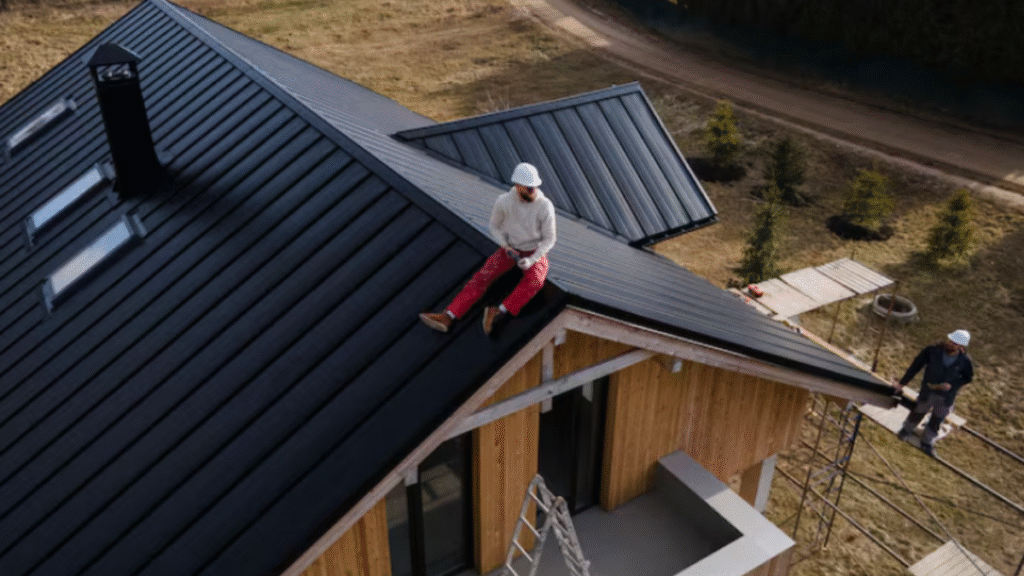The roof is a vital component of every home, shielding families from the elements and contributing significantly to a house’s overall appearance and value. When it comes to residential roofing, choosing the right materials, installation methods, and maintenance practices ensures long-lasting protection and comfort.
This article delves into the fundamentals of residential roofing, covering types of roofing materials, the installation process, signs of roof damage, maintenance tips, and how to select the right contractor. Whether building a new home or replacing an aging roof, understanding residential roofing helps homeowners make informed decisions that safeguard their investment.
What is Residential Roofing?
Residential roofing refers to roofing systems specifically designed and installed for houses and residential buildings. Unlike commercial roofing, which often involves flat roofs or specialized membranes, residential roofs typically feature pitched designs using materials that balance durability, aesthetics, and cost.
A well-designed residential roof protects occupants from rain, snow, wind, heat, and cold, while providing insulation and ventilation that enhance energy efficiency.
Common Types of Residential Roofing Materials
Homeowners have a variety of materials to choose from, each with distinct benefits and drawbacks:
Asphalt Shingles
Asphalt shingles are the most popular residential roofing material due to affordability, ease of installation, and availability in numerous styles and colors. They typically last 20 to 30 years and perform well in most climates.
Metal Roofing
Metal roofing is growing in popularity for residential properties because of its longevity (often 40-70 years), durability, and energy efficiency. It resists fire, rot, and pests, and comes in panels or shingles that mimic traditional materials.
Wood Shingles and Shakes
Wood shingles provide a natural, rustic look favored for certain architectural styles. However, they require maintenance to prevent rot and insect damage and are less fire-resistant unless treated.
Tile Roofing
Clay or concrete tiles offer excellent durability and fire resistance, with a lifespan often exceeding 50 years. They are heavy and may require additional roof support.
Slate Roofing
Slate is a premium roofing material prized for its elegance and extreme durability. It is one of the longest-lasting materials but also the most expensive and heavy.
Synthetic Roofing
Synthetic roofing materials are engineered to replicate the look of wood, slate, or tile while offering enhanced durability and lower maintenance.
The Residential Roofing Installation Process
Professional installation is key to ensuring a roof performs well throughout its lifespan. Typical steps include:
- Inspection and Preparation: The old roofing is inspected and removed if necessary. Roof decking is assessed for damage and repaired.
- Underlayment Installation: A protective moisture barrier (underlayment) is installed over the decking to prevent leaks.
- Flashing Installation: Flashing is installed around chimneys, vents, and edges to prevent water infiltration.
- Roofing Material Installation: Shingles, tiles, or panels are installed according to manufacturer instructions and local codes.
- Final Inspection: The roof is inspected for quality, and any debris is cleaned up.
Signs Your Residential Roof Needs Repair or Replacement
Identifying roofing problems early helps avoid costly damage. Common signs include:
- Missing, cracked, or curling shingles
- Granule loss visible in gutters
- Water stains or leaks inside the home
- Sagging roof deck or flashing damage
- Increased energy bills due to poor insulation
A professional roof inspection can confirm the condition and recommend necessary action.
Residential Roofing Maintenance Tips
Proper maintenance extends the life of your roof and protects your home:
- Keep gutters clean to prevent water buildup
- Trim trees to avoid branch damage
- Remove debris like leaves and branches regularly
- Inspect the roof after storms
- Address minor damage promptly before it worsens
Routine maintenance saves money in the long run by preventing major repairs or premature replacement.
How to Choose a Residential Roofing Contractor
Selecting the right contractor is crucial for quality results. Consider:
- Licensing and insurance verification
- Experience with your roofing material and style
- Positive customer reviews and references
- Detailed written estimates and transparent pricing
- Warranty offerings on workmanship and materials
Good communication and professionalism make the project smoother and more reliable.
Energy Efficiency and Residential Roofing
Modern residential roofing options can contribute to energy savings through:
- Reflective coatings that reduce heat absorption
- Proper ventilation that regulates attic temperature
- Insulating materials that reduce heating and cooling costs
Choosing energy-efficient roofing supports environmental goals and reduces utility bills.
Conclusion
Investing in quality residential roofing is essential to protect your home and family. Understanding material options, recognizing signs of wear, and maintaining your roof properly ensures it provides lasting shelter and enhances your property’s value.
Whether replacing an old roof or installing a new one, working with trusted professionals guarantees a durable and beautiful roofing solution tailored to your home’s needs.







